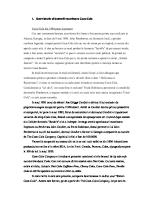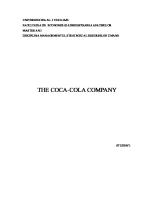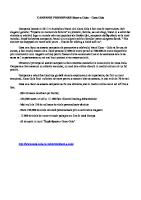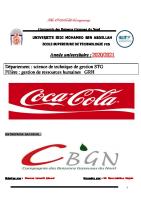Coca Cola ERG Theory [PDF]
1. COMPANY PROFILE a) INTRODUCTION b) MISSION c) VISION 2. ALDERFER’S ERG THEORY a) DEFINITION b) ERG THEORY USED WITHIN
42 0 455KB
Papiere empfehlen
![Coca Cola ERG Theory [PDF]](https://vdoc.tips/img/200x200/coca-cola-erg-theory.jpg)
- Author / Uploaded
- Hina Mehak Aziz
Datei wird geladen, bitte warten...
Zitiervorschau
1. COMPANY PROFILE a) INTRODUCTION b) MISSION c) VISION 2. ALDERFER’S ERG THEORY a) DEFINITION b) ERG THEORY USED WITHIN COCA-COLA COMPANY Relatedness Existence Growth 3. IMPORTANCE OF MOTIVATION IN WORKPLACE 4. CONCLUSION
COMPANY PROFILE INTRODUCTION The Coca-Cola Company, incorporated on September 5, 1919, is a beverage company. The Company owns or licenses and markets non-alcoholic beverage brands, primarily sparkling beverages and a range of still beverages, such as waters, flavored waters and enhanced waters, juices and juice drinks, ready-to-drink teas and coffees, sports drinks, dairy and energy drinks. The Company's segments include Europe, Middle East and Africa; Latin America; North America; Asia Pacific; Bottling Investments, and Corporate. The Company owns and markets a range of non-alcoholic sparkling beverage brands, including Coca-Cola, Diet Coke, Fanta and Sprite. As of December 31, 2016, the Company owned or licensed and marketed over 500 non-alcoholic beverage brands. The Company markets, manufactures and sells beverage concentrates, which are referred to as beverage bases, and syrups, including fountain syrups (concentrate business or concentrate operations), and finished sparkling and still beverages (finished product business or finished product operations). The Company makes its beverage products available to consumers across the world through its network of Company-owned or -controlled bottling and distribution operations, as well as bottling partners, distributors, wholesalers and retailers
MISSION Our Roadmap starts with our mission, which is enduring. It declares our purpose as a company and serves as the standard against which we weigh our actions and decisions. •
To refresh the world...
•
To inspire moments of optimism and happiness...
•
To create value and make a difference.
VISION Our vision serves as the framework for our Roadmap and guides every aspect of our business by describing what we need to accomplish in order to continue achieving sustainable, quality growth. •People: Be a great place to work where people are inspired to be the best they can be. •Portfolio: Bring to the world a portfolio of quality beverage brands that anticipate and satisfy people's desires and needs. •Partners: Nurture a winning network of customers and suppliers, together we create mutual, enduring value. •Planet: Be a responsible citizen that makes a difference by helping build and support sustainable communities. •Profit: Maximize long-term return to shareowners while being mindful of our overall responsibilities. •Productivity: Be a highly effective, lean and fast-moving organization.
ALDERFER'S ERG THEORY Alderfer further developed Maslow's hierarchy of needs by categorizing the hierarchy into his ERG theory (Existence, Relatedness and Growth). The existence group is concerned with providing the basic material existence requirements of humans. They include the items that Maslow considered to be physiological and safety needs. The second group of needs is those of relatedness – the desire people have for maintaining important interpersonal relationships. These social and status desires require interaction with others if they are to be satisfied, and they align with Maslow's social need and the external component of Maslow's esteem classification. Finally, Alderfer isolates growth needs: an intrinsic desire for personal development. These include the intrinsic component from Maslow's esteem category and the characteristics included under self-actualization.
ERG THEORY USED WITHIN COCA-COLA COMPANY Coca Cola is one of the most successful of the beverage of industry all over the world. Nowadays in every successful business they must have a good way to motivate their staff. In Coca Cola one of their way to motivate staff is through the working performance of employee, since if employee is hard to work, the company could motivate them by improving their occupational opportunities and awarding them. These methods
can make a key role to create working environment where it can stimulate not just engagement but also achievement. Awarding and occupational opportunities can inspire workers so that it could strengthen their team spire, their skill of leading, decision making, communication between staff and it can gain much more commitment to the company and motivation.
EXISTENCE NEEDS The existence needs of the employees within The Coca-Cola Company be defined as those needs that have a desired physiological effect on the employees within the company. In addition, it could be the material well-being of the organization itself. In order for there to be harmony within the company, the employees must have a sense of stability in their current position, as well as a potential for growth within the company. Remembering that employees have the desire to be satisfied within the company in which they work, The Coca-Cola Company has many different programs in place in order to assist with this process. For example, the company offers cultural awareness programs and employee forums; these forums consist of employees that share similar interest or backgrounds. The individuals within these forums provide both professional and personal growth to one another. The Coca-Cola Company motivates their employees with incentives and occupational opportunities on a daily basis. The material well-being of The Coca-Cola Company is being achieved each day. The company uses innovative means in order to reach the younger generation of today.
RELATEDNESS The next part of the ERG Theory is the relatedness needs.The Coca-Cola Company prides themselves on establishing relationships between both employer and employee. The organization is able to connect with the employee and produce a relationship that can benefit both of them. For example, The Coca-Cola Company uses the one-on-one approach between management leaders and employees. Once a month, the employee speaks with a team leader, or supervisor, about any problems at home or in the workplace. This creates a positive environment where both parties can start to build a trusting relationship with one another. As a result, this could help them improve productivity because they are able to express personal needs that could affect their performance at work. Another reason why The Coca-Cola Company uses the relatedness need is to build meaningful relationships between co-workers. If an individual likes who he or she is working with, they tend to be more motivated to continue to come to work for the personal relationship and networking. The human need is easily satisfied in the simplest form.
GROWTH NEED The growth need, which Schermerhorn, Jr., Hunt, and Osborn (2002) state as the desire for continued personal growth and development (p. 156). This need alone can motivate each and every employee to do better within themselves, as well as within the job. Knowing that some of the choices made at work can help you advance, is something that helps reassure an individual that advancement is up to him or her. The Coca-Cola Company tries to create an environment where promotions are encouraged to come from within the organization. Furthermore, they implement training programs which encourages an individual to move ahead in the company if, and when, the opportunity exists. The company also practices several incentive and reward programs to help motivate the employees to continuously improve productivity.
IMPORTANCE OF MOTIVATION IN THE WORKPLACE Motivation can emanate from with an employee with a passion and desire to work and produce results. This kind of motivation is self-driven by an employee in order to elevate his feelings to accomplish. However, in extrinsic motivation, an external factor such as a reward is used to boost the employee’s moral and desire to work. As is a normal case, employees work in exchange for compensation for their hard labour but how far
they go depends on how motivated they are. According to Perry and Hondeghem (1999), the individuals desire to perform, and provide services to customers, with the mandate to do good is enough factor to motivate. Performance at work is related to the employees pay of which the employee may not have control of that reward as it is external. Apart from rewards, there are other factors that are external such as promotion at work, security of the job, salary increment that may give meaning to employees motivation. Therefore, for organizations to continue existing and retaining its workforce, they must keep on working on strategies that can help in motivating its employees. Motivated employees have a sense of belonging and loyalty to the organization and always work hard to be associated with the results of their labour. Motivation have effect on employees as individuals to achieve and as well as ability to be innovative because they believe in themselves which will benefit the organization to succeed (Yang Jie, 2010). A motivated worker is easy to be retained hence saving the organization finances of replacing workers, also it encourages workers to always achieve more on daily productions as they are having a sense of security of their work. Management will have time to attend to other important issues because their motivated workforce can build teams that can help with the supervision and production of work.
CONCLUSION Motivation is very much needed for employees in an organization to be productive, and management or leadership style has an important role to play. Motivation is not always based on financial rewards, but non-financial rewards methods can also be used to derive the best out of employees. In terms of empowering workforce, employees should be encouraged and given a platform to voice out their concerns on how they can be motivated. Rewards and promotions following performance appraisals maybe used to boost employee’s moral as well as feedback. In some organizations, workers perform their duties in an assembly whereby if a certain section of employees is affected it will affect the whole plant. Employees perform their duties diligently if they are inspired and motivated as the results will always be positive with efficient production. Organizations which are results oriented will go all the way to motivate their employees for them to reach their goals.









